1. Raise and support the vehicle and remove the wheel and brake drum from the wheel to be worked on.
2. Install a clamp over the ends of the wheel cylinder to prevent the pistons of the wheel cylinder from coming out, causing loss of fluid and much grief.
3. Contract the brake shoes by pulling the self-adjusting lever away from the starwheel adjustment screw and turn the starwheel up and back until the pivot nut is drawn onto the starwheel as far as it will come.
4. Pull the adjusting lever, cable and automatic adjuster spring down and toward the rear to unhook the pivot hook from the large hole in the secondary shoe web. Do not attempt to pry the pivot hook from the hole.
5. Remove the automatic adjuster spring and the adjusting lever.
6. Remove the secondary shoe-to-anchor spring with a brake tool. (Brake tools are very common implements and are available to auto parts stores). Remove the primary shoe-to-anchor spring and unhook the cable anchor. Remove the anchor pin plate.
7. Remove the cable guide from the secondary shoe.
8. Remove the shoe holddown springs, shoes, adjusting screw, pivot nut, and socket. Note the color of each holddown spring for assembly. To remove the holddown springs, reach behind the brake backing plate and place one finger on the end of one of the brake holddown spring mounting pins. Using a pair of pliers, grasp the washer type retainer on top of the holddown spring that corresponds to the pin which you are holding. Push down on the pliers and turn them 90 degrees to align the slot in the washer with the head on the spring mounting pin. Remove the spring and washer retainer and repeat this operation on the hold down spring on the other shoe.
9. Remove the parking brake link and spring. Disconnect the parking brake cable from the parking brake lever.
10. After removing the rear brake secondary shoe, disassemble the parking brake lever from the shoe by removing the retaining clip and spring washer.
11. Assemble the parking brake lever to the secondary shoe and secure it with the spring washer and retaining clip.
12. Apply a light coating of Lubriplate  at the points where the brake shoes contact the backing plate.
13. Position the brake shoes on the backing plate, and install the holddown spring pins, springs, and spring washer type retainers. On the rear brake, install the parking brake link, spring and washer. Connect the parking brake cable to the parking brake lever.
14. Install the anchor pin plate, and place the cable anchor over the anchor pin with the crimped side toward the backing plate.
15. Install the primary shoe-to-anchor spring with the brake tool.
16. Install the cable guide on the secondary shoe web with the flanged holes fitted into the hole in the secondary shoe web. Thread the cable around the cable guide groove.
17. Install the secondary shoe-to-anchor (long) spring. Be sure that the cable end is not cocked or binding on the anchor pin when installed. All of the parts should be flat on the anchor pin. Remove the wheel cylinder piston clamp.
18. Apply Lubriplate  to the threads and the socket end of the adjusting starwheel screw. Turn the adjusting screw into the adjusting pivot nut to the limit of the threads and then back off 1 / 2 turn.
Interchanging the brake shoe adjusting screw assemblies from one side of the vehicle to the other would cause the brake shoes to retract rather than expand each time the automatic adjusting mechanism is operated. To prevent this, the socket end of the adjusting screw is stamped with an "R" or an "L" for "RIGHT" or "LEFT". The adjusting pivot nuts can be distinguished by the number of lines machined around the body of the nut; one line indicates left hand nut and two lines indicate a right hand nut.
19. Place the adjusting socket on the screw and install this assembly between the shoe ends with the adjusting screw nearest to the secondary shoe.
20. Place the cable hook into the hole in the adjusting lever from the backing plate side. The adjusting levers are stamped with an R (right) or a L (left) to indicate their installation on the right or left hand brake assembly.
21. Position the hooked end of the adjuster spring in the primary shoe web and connect the loop end of the spring to the adjuster lever hole.
22. Pull the adjuster lever, cable and automatic adjuster spring down toward the rear to engage the pivot hook in the large hole in the secondary shoe web.
23. After installation, check the action of the adjuster by pulling the section of the cable guide and the adjusting lever toward the secondary shoe web far enough to lift the lever past a tooth on the adjusting screw starwheel. The lever should snap into position behind the next tooth, and release of the cable should cause the adjuster spring to return the lever to its original position. This return action of the lever will turn the adjusting screw starwheel one tooth. The lever should contact the adjusting screw starwheel one tooth above the centerline of the adjusting screw.
If the automatic adjusting mechanism does not perform properly, check the following:
24. Check the cable and fittings. The cable ends should fill or extend slightly beyond the crimped section of the fittings. If this is not the case, replace the cable.
25. Check the cable guide for damage. The cable groove should be parallel to the shoe web, and the body of the guide should lie flat against the web. Replace the cable guide if this is not so.
26. Check the pivot hook on the lever. The hook surfaces should be square with the body on the lever for proper pivoting. Repair or replace the hook as necessary.
27. Make sure that the adjusting screw starwheel is properly seated in the notch in the shoe web.

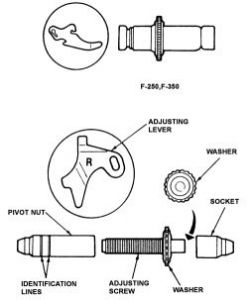
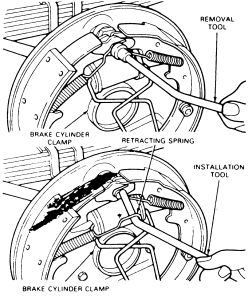
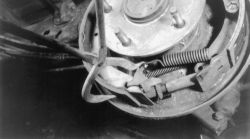
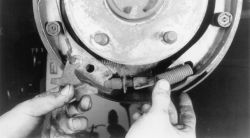
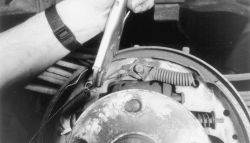
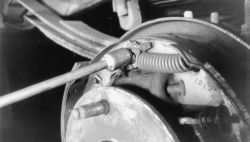
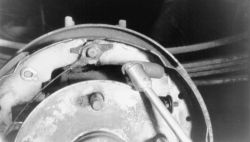
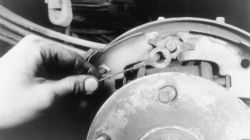
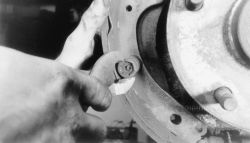
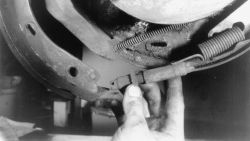
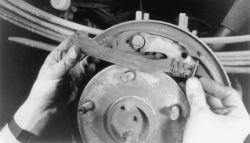
SPONSORED LINKS
Tuesday, April 6th, 2021 AT 12:12 PM














